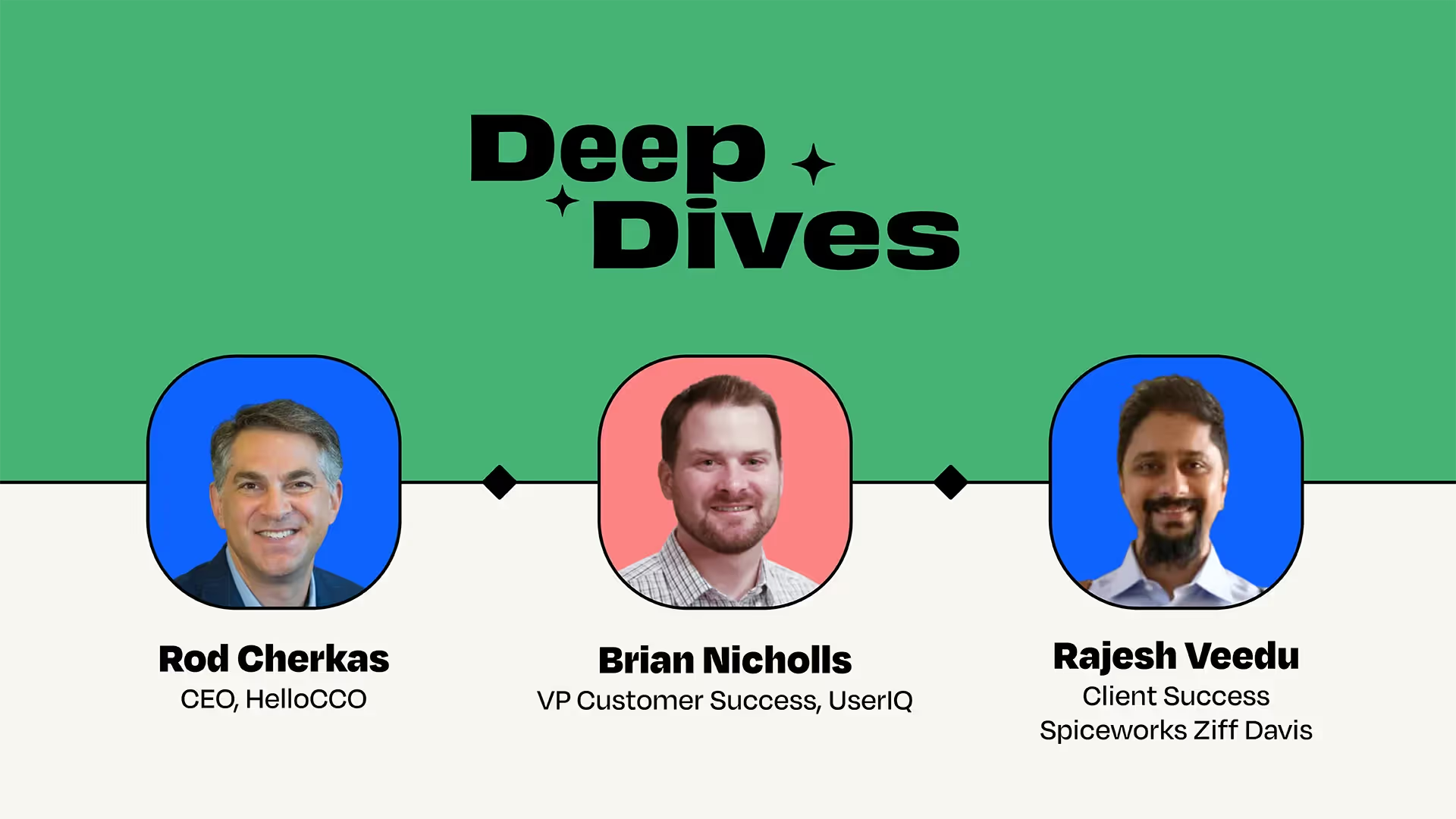For our first-ever Deep Dives session, we had Rod Cherkas, CEO - Hello CCO, Brian Nicholls, VP - Customer Success at UserIQ, Rajesh Veedu, CSM - Spiceworks Ziff Davis, and Srikrishnan Ganesan, Co-founder - Rocketlane share their experiences, insights, and advice on expectation management and escalations.
Rod works with Chief Customer Officers and other post-sale leaders to help scale their organizations through various stages of growth. Throughout his career, he’s worked with fast-growing enterprise SaaS companies such as RingCentral, Marketo, and Gainsight and led post-sale functions, including Customer Enablement and Professional Services.
Brian has worked on customer experience, customer success, and customer engagement throughout his career.
Rajesh manages Client Services at Spiceworks Ziff Davis, a global marketplace that connects technology buyers and sellers. A bulk of his experience in post-sales experience has been in Account Management and CS roles at Kaseya and Replicon.
In the rest of this post, we share some of our key takeaways from this discussion.
Expectation management during customer onboarding
- Setting realistic expectations right at the start of the post-sale process: Use the kickoff meeting/call to align expectations, communicate the next steps, and the resource and time commitments required from the customer for the duration of the project. Document and share key points in a simple, easy-to-consume format with the customer.
- Resetting and adjusting expectations along the way: Ensure that you set and reset expectations proactively on an ongoing basis. For instance, at the end of every meeting, summarize key changes or adjustments, talk about what’s next, ensure your follow-ups communicate this, and also lay down the next set of activities or action items for your team and theirs.
- Bridging the purchase-to-post-sale gaps for the customer: Likely, the post-sales team/project manager you’re working with was not involved in the sales cycle. Take the time to provide them the context needed to build alignment on what's needed from them so both teams can get started successfully.
- Setting clear ‘yes’ and ‘no’ expectations: There will always be cases beyond the current scope of the project; be comfortable saying no to customers. Whether it is an outright impossibility in the worst case or a possibility farther down the line in the best case, communicate this explicitly to the customer instead of leaving them hanging.
Best practices and tips for handling uncomfortable or difficult conversations
- Keep communication timely, open, and transparent: Whether it is a meeting before things go awry or an urgent status update, document and communicate any expectations (or changes in them). Ensure to highlight the next steps, timelines, and PoCs to demonstrate accountability and assure customers that you’re working to keep the project moving forward.
- Build communication lines at multiple levels, including the leadership team: Make communication for difficult conversations a multi-step/level process that involves the Implementation Manager, the CSM, and the department/function lead, depending on the severity of the issue.
- Ensure acknowledgment from the customer on critical developments: It's one thing to communicate a change and document it, but expectation-setting is not complete till your customer acknowledges it, preferably in writing.
Typical reasons for post-sale challenges
- Gaps between their understanding of the post-sale process and the actual process: This includes cases where time, resource, and effort expectations from the customer’s end are not accurately set in the sales cycle. This can be minimized by setting strong Sales-to-Success handoffs, organizing effective kickoff meetings, and ensuring timely communication throughout the onboarding journey. Another big part of this issue is inconsistent messaging to the customer across sales and onboarding. Investing time and effort in the documentation and ensuring that Sales and Onboarding/Implementation work closely can help solve this issue to a large degree.
- An overcomplicated post-sales process: Products can do a lot of different things for different customers. Instead of overwhelming a new customer with all the product’s capabilities, pick out one or two key items that the customer can benefit from early on in their journey, so they see value faster.
- Customers start ghosting or ‘go dark’: The urgency that the Implementation team feels given their deadlines, constraints, and targets is often quite different from the urgency that the customer feels. Naturally, this could lead to delays and escalations at later stages. A robust system to help keep customers accountable for their commitments can help minimize the risks of this.
- Selling the wrong implementation package to close deals: Often done to minimize price-related friction, selling lower-rung packages to customers gives the implementation team a hard time during implementation, and customers, a possibly sub-optimal outcome at the end of onboarding/implementation.
How pre- and post-sales interactions impact your business
Handling product issues and escalations post-go-live
- Get all hands on board when needed: While the CSM is ultimately responsible for a customer’s success and ensuring that any problems move through the proper process, they need to be supported by the Product team or Implementation or Support or the senior leadership. Ensure internal accountability and transparency for issues, so it's clear who takes responsibility for identifying, diagnosing, and resolving the product issue.
- Get to the root cause of the issue: Pay attention to the frequency of issues and escalations to identify any themes or potential root causes. Whether it is expectation-setting during the sales cycle, a recurring product issue or feature request, or a resource constraint within the team, take a proactive approach to limit the recurrence of such issues. While it can be challenging for a CS leader to balance the day-to-day delivery with the need for deeper investigation and long-term solutions, zooming out to figure out any underlying patterns is a big part of the role.
The right CS team culture how to foster it
- Listen to the customer: Stay committed to taking the time to understand what they want, what they're trying to get to, and what the reason behind their escalation is. This is equally applicable for CS leaders; customers will feel reassured when senior team members take the time and make an effort to listen to them.
- Empower the team to take action at their level: Encourage the team first to try multiple approaches to solve customers’ issues at their end before getting the Product team or senior leadership involved. Over time, this will build their capacity to dealing with difficult situations and customers.
- Have the team’s back at all times: A big part of a CS leadership role is in helping the team resolve issues by working with them to talk to clients when challenging situations arise. Ensure that team members feel comfortable escalating issues to the leadership when necessary.
- Support customer-facing team members to tackle the negativity that comes their way: Thanks to wrongly-set expectations, product issues, and multiple other factors outside their control, customer-facing members end up dealing with more than their share of stressful situations.
Ensure healthy communication even within the team - be it setting in place weekly rituals where team members discuss problems they’re struggling with, or actively practicing positive reinforcement by acknowledging and appreciating contributions, problems solved, and lessons learned,
Hiring for CS roles
- The reverse interview trick: Ask prospective recruits to pose questions to you about the role they’re applying for, its responsibilities, the team/function they’re looking to join, etc., to get an understanding of their thought process, their priorities, and their ability to dig deep and ask the right questions.
- The right questions to ask: Use a mix of hypothetical and reflective questions in the interview process to assess their innate skills and qualities and their past experiences and abilities. Hypothetical questions can help gauge if they’re able to think on their feet, how creative and tactical their approach is, and how process/structure-driven their working style is. Reflective questions that need them to draw from their experiences of dealing with difficult professional situations are good ways to understand their fit for the role. Irrespective of the outcome they were able to achieve in their past experiences, you can better understand their sense of accountability and ownership and see how they would work through and handle similar situations at your company. For implementation roles, focus on questions that give prospective team members a chance to exhibit their problem-solving skills using real-life instances or examples.
- Mindsets and attitude: Curiosity and the confidence to explore that curiosity to do what’s best for the team and the customer are key attributes of a good CS professional. In addition, a candidate’s level of preparedness for an interview and their ability to stay calm and composed through it indicate the preparation and temperament they would take to a stressful situation with a customer.
Advice for CS professionals
1. Be proactive: Focus on minimizing opportunities for issues escalations. Pay attention to the frequency and cause of common escalations and seek the support of other teams to fix the root cause.
2. Don’t leave the customer hanging: Whatever the situation, always close the loop with the customer, not just for ‘yes/no’ situations but even for the ‘maybe’ ones.
3. Be flexible: Though systems, processes, and operational aspects are a big part of your role as a CS/Implementation/Onboarding professional, the conditions you work in are always dynamic. Playbooks and templates go a long way in setting the team and the customer up for success. But a flexible and evolving approach to systems and processes is the best way to ensure success with different and new kinds of customers.






















.webp)
